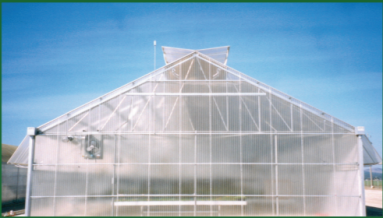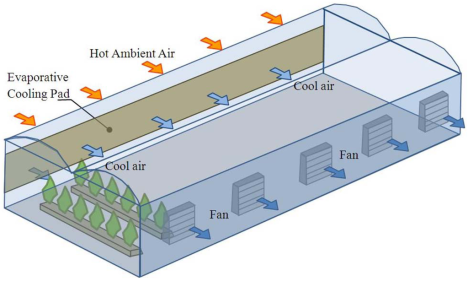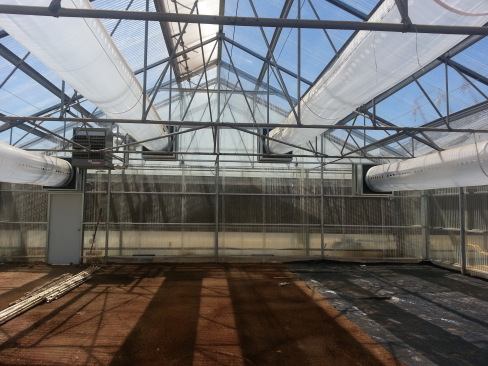Daniel Monk of Agratech takes us through a few heating and cooling options in a greenhouse, and explains to us the benefits and drawbacks of each.

The following is an article produced by a contributing author. Growers Network does not endorse nor evaluate the claims of our contributors, nor do they influence our editorial process. We thank our contributors for their time and effort so we can continue our exclusive Growers Spotlight service.
Disclaimer
This article was originally published on another website. If you would like to read the original article, click here.

Greenhouse cooling and ventilation systems have a direct influence on what enters and exits the greenhouse. This is especially important in warmer climates where a large volume of air is constantly being pushed throughout the grow area. Regardless of whether you are pulling or pushing this air, the structure is important not only for temperature management, but also in pest control.
There are three fundamental greenhouse-cooling systems:
- Natural ventilation
- Negative pressure
- Positive pressure
If your crop is one that thrives in an insect-free environment, one of these systems is the superior choice, providing optimal temperature control and pest control.
Natural Ventilation
 |
 |
Now I know what you’re thinking. What’s the cheapest option?
Well, the cheapest option is natural ventilation. Natural ventilation can be very effective at controlling air temperature in the right climates, however, the price and temperature control often sacrifices the potential for insect exclusion. Insect screens/nets for passively or naturally ventilated greenhouses can still result in undesirably high air temperatures as they restrict natural airflow.
In warmer climates where temperature control and pest management is important to the survival of the crop, a negative or positive pressure cooling system is usually the better choice.
Negative Pressure

A negative-pressure cooling system relies on pulling air through the greenhouse with exhaust fans. The process pulls outside air through cooling pads or a cooling wall located on the opposite wall from the exhaust fans.
During this process, cool air is traveling from one end of the greenhouse to the other, mixing with the warm air in the greenhouse. The heat from the warm air then transfers into the cool air, resulting in fluctuating air temperatures throughout the structure.
The coldest air is found closest to the cooling wall, while temperatures continually rise as the air approaches the exhaust wall. This can be a substantial change in air temperature from one end of the greenhouse to the other depending on square footage, climate, rate of airflow, etc. Furthermore, as the air is pulled into the greenhouse, insects can also be pulled in through any opening in the structure (doors, vents, tears, cracks, and more) Fortunately, this infiltration can be prevented up to a point with the proper insect screens in the right locations, usually both at air inlets and outlets.
Positive Pressure

A positive pressure cooling system forcefully pushes cool air through ducting into the greenhouse. The air can escape through any openings (doors, vents, tears, cracks), but it is at a pressure high enough that any flying insects attempting to enter will be repelled by the air speed. A system like this creates a uniform temperature through the growing space at +/- 2 °F. To avoid pushing insects into the greenhouse, this type of system does require an insect screen or filter at the air inlet. For example, a positive pressure cooling system like Agra Tech’s Agra Kool II in combination with Svensson’s ECONET 1515 can offer superior cooling while also excluding pests even as small as a thrip.
Overall, depending on your crop and pest control goals, the proper cooling system can have a profound impact on more than just temperature, as it also presents the opportunity to reduce pesticide use. Additionally, the process of pushing air through the greenhouse via positive pressure has been shown to be more effective in excluding insects than a negative pressure exhaust system, which tends to pull insects into the greenhouse. Depending on your crop, location, cooling, and pest management goals, a positive pressure cooling system may be an appealing investment.
Do you have any experience with this topic? How do you cool your greenhouse? Do you have any recommendations? Please leave your thoughts in the comment section below.
10 Best Gift Ideas for Cannabis Connoisseurs and Growing Aficionados (2022)
December 7, 2022Developing and Optimizing a Cannabis Cultivation System
December 14, 2021Dealing with Insomnia: How Can CBD Help?
December 10, 2020Your Guide to Sleep and CBD
December 7, 2020
Do you want to receive the next Grower's Spotlight as soon as it's available? Sign up below!

Do you have any questions or comments?

About the Author
Agra Tech is rated the best greenhouse manufacturer in the west by commercial greenhouse operators, and number 4 nationally. We manufacture many commercial greenhouse designs for precise environmental control to shade houses and tunnels to protect your crop and extend your growing season.